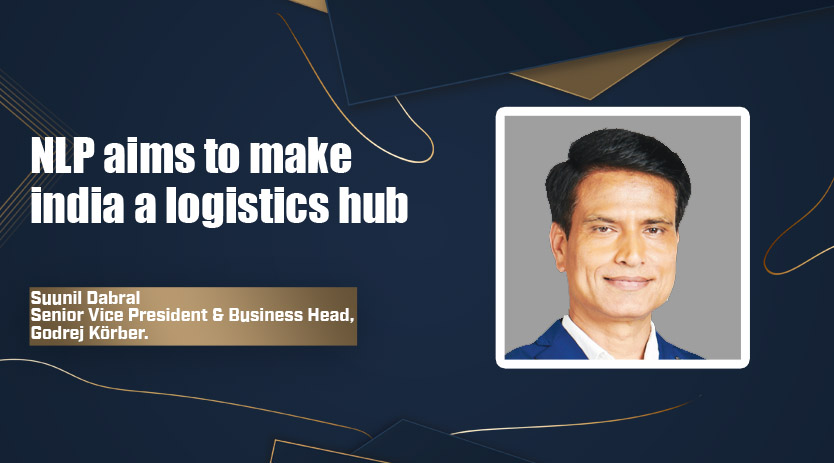Algorithms built into the Warehouse Control System can potentially decrease the time and resources required to conduct repetitive tasks inside the freezer room and boost the overall productivity of a cold store.
Perception about the rising need for automation in India’s cold chain sector
Over the past two years, India’s demand for fresh produce and perishable food items has grown, increasing the requirement for cold chain transportation to deliver goods to a wide area of the nation. Automation in warehouses is increasingly being adopted as the best way to improve reliability and efficiency in material handling while meeting the ever-increasing expectations of end customers. The introduction of AIs & automated technology have changed the dynamics of logistics & equipping it with a cold chain has maximised the efficiency of cold chain logistics. For regulation, temperature control, routine check & analysis of data, these automated processes and AIs help with ample benefits & promote a smooth working of the cold chain logistics. The Indian cold chain industry was valued at USD 19.6 billion in 2020 and is projected to reach USD 36 billion by 2024, growing at a CAGR of 16%, according to ISHRAE – Indian Cold Chain Industry Outlook 2024 Report. Godrej Körber is expecting 18 – 20 percent growth in the next five years as it has witnessed a significant shift towards adopting automation in the supply chain after the pandemic and expects this trend to continue.
Progress India made in adopting modern automation technologies for cold chain storage
Since the pandemic, the government and businesses have begun to pay attention to cold chains. Nowadays, the focus is on the efficiency that automation brings to the table rather than its significance. Powerful algorithms built in the powerful Warehouse Control System (WCS) can potentially decrease the time and resources required to conduct repetitive tasks inside the freezer room while also boosting the overall productivity of a cold store. With Asia emerging as a development engine for supply chain automation, Körber Supply Chain intends to bring the latest global technologies to India through its Indian subsidiary Godrej Körber in the coming years.
Intralogistics solutions – saving transit time in plants and facilities
The key to success is optimising facilities and processes, using connected technology to see changes visually, and using automated solutions to increase the material handling performance dramatically with accuracy & transparency. The skillfully designed intralogistics material flow inside a warehouse or distribution centre doesn’t only reduce the transit time inside the warehouse but also enhances the storage density with proper access to the material. By utilising horizontal and vertical space inside a warehouse or a cold store, the solutions like automated storage and retrieval systems (AS/ RS) help quickly and effectively move goods through the facilities. AS/RS systems enable warehouses (Ambient or cold) to operate more productively, conserve valuable space, and boost efficiency by eliminating wasted transit time. Godrej Körber also offers various conveyors and rail-guided vehicle (RGV) systems that quickly and efficiently link far-off places. Conveyors can help in speedily moving products from one location to another, thereby reducing transit time – and can be provided in modular lengths/widths and payloads.
Partnership of Godrej Körber with German-based Körber
Godrej & Boyce joint ventured with Germany-based Körber Supply Chain to pioneer the role of intralogistics across different sectors by offering differentiated automation solutions through its joint venture company Godrej Körber. This partnership will conquer supply chain complexities with solutions from materials handling automation equipment to advanced software like WCS & WMS and further provide life cycle management services. Körber, as a business, has decided to focus on investments in Asia. This partnership will enable us to work together to accomplish this goal.
India is a crucial market and has a plethora of scope. We are targeting to grow at a CAGR of 18 percent between 2023 – 2025 by opening up new market sectors and penetrating the Cold Chain, Retail and E-commerce industries.
Investment strategy adopted for technology and R&D of products for cold chain management To make India an automation hub for the cold chain industry, we are investing in the latest technologies through our joint venture with the Körber Supply chain. We are providing modern automation solutions to design efficient and smart warehouses for our customers across 10 manufacturing value chains projected to add over $300 billion to the Indian manufacturing GDP. We have smart ASRS systems, conveyors, transfer cars, shuttles, and AGV/AMRs, which are energy-efficient machines and help our customers to achieve their sustainability goals. By integrating advanced technology and innovation, we aspire to tackle supply chain complexities across sectors and automate many cold chain warehouses in India. It goes without saying that today’s technology landscape is constantly changing while making certain technological solutions obsolete. Therefore, for any business to prosper, there must be a strong emphasis on the R&D function. We have plans to invest ambitiously in R&D, and the team has also grown in numbers.
India Government’s policies and initiatives encouraging the adoption of automation in cold storage
The government of India has announced the National Logistics Policy, which aims to develop a technologically enabled, integrated, and sustainable logistics eco-system. All of this cannot happen without adopting automation and IT. The government has announced 41 mega food park projects, and around 22 mega food parks are operational. Mega food parks consist of collection centres, processing centers, cold chain facilities, etc. This scheme would create 5,000 jobs and will benefit 25,000 farmers. The cold stores in the mega food parks will have to perform at their best because the value chains will put a lot of pressure on the overall output of the mega food park. The National Logistics Policy (NLP) would make it possible for the Indian logistics and warehousing industry to interact and be more transparent.
The government is promoting the development of cold chains in the country with the goal of food security in hindsight due to the wastages in the value chains of the perishables. The government has also made an ambitious goal of doubling the milk processing industry by increasing the country’s capacity by 2025, i.e. from 54 million tons to 103 million tons. Hence, the milk processing industry will invest in cold storage facilities. Similarly, the emergence of organised 3PLs, pharmaceutical, retail, e-commerce, and food service industries will require a good network of cold chains. Adopting automation and technologies will enable the output or efficiency of the cold chain industry, where Godrej Körber positions itself as an “Enabler”. The National Logistics Policy, unveiled by Prime Minister Narendra Modi, aims to address issues facing the transportation industry and reduce company logistics costs from 13–14 percent of GDP to a single digit in the future years. National Logistics Policy mentions that India has built Cold Storage facilities at 30 airports across India. By providing diverse modes of transportation and utilising technology and experienced labour, the policy aims to pave the path for India to become a logistics hub.
Challenges faced by manufacturers and suppliers of cold chain goods
Aside from needing to pay the labour working in cold storage more than in a dry environment, there are also major concerns such as attrition and difficulty recruiting individuals to work in freezing warehouses. Automation technologies such as ASRS systems, shuttles systems, Conveyors, AGVs, and Layer Picker solutions can guarantee faster delivery, allowing for less footprint and maximised space utilisation in the facilities.
The cold stores consume a lot of power to maintain the temperature and thus put a lot of strain on the environment, which results in an increased carbon footprint. Hence the industry will also have to consider energy-saving technologies to offset the negative environmental impact and be more sustainable. The higher cost of operations in cold storage makes it critically important that the space must be utilised in the best optimal manner. At Godrej Körber, we focus on modern cold stores that employ modern technologies and where the investment in robotics and automation can be justified.
World Dairy Summit in its approach
The Dairy summit took place after 48 years; we saw this as almost a once-in-alifetime event. It brought together all the stakeholders from the dairy industry and the milk Processing industry. We met our existing customers and future customers. At this moment, we can say all collective future potential in the next eight months was foreseen around 1,20,000 pallets as an estimate based on our discussions with the key players. Due to the existing relationships with the key stakeholders and the recent movements in the Indian dairy cluster, we hope to see a big race for adopting automation technologies. We have already started the design consulting and the capacity planning in the milk processing segment value chain with a few stakeholders and consultants.
Modern technologies offered for cold chain intralogistics by Godrej Körber
An automated cold storage facility’s purpose is to expedite processes and increase safety for staff and commodities by increasing the overall performance of the cold store. Godrej Körber aims to bring this transformation to India’s cold storage facilities by providing special high-density storage automation solutions, including stacker cranes and shuttle based AS/RS solutions that let you fully control the storage of all palletised commodities without the need for manual handling.
Warehouses across industries, including Pharmaceuticals, Paints, FMCG, and manufacturing, are moving from manual forklift-based operations to advanced Automated Storage and Retrieval Systems (ASRS). Autonomous technologies (AGVs, AMRs), including robotics technologies and more, are designed to move materials throughout a warehouse, and robotics systems to pick and put away products and also replenishment. Godrej Körber’s automated stacker cranes offer greater capacity, load, and height capabilities than manually operated forklifts. They are highly accurate and fast with highperformance design ensuring error-free, fast, and safe storage and retrieval operations in a high bay warehouse, typically from 20 meters to 45 meters.
Moreover, Godrej Körber’s Warehouse Management System software is based on standard modules implemented in different operations worldwide. It may be configured to best fit any customer’s specific operational requirements or different languages. It maximises supply chain efficiency by automating key processes from goods receiving, storage, and picking to fulfilling outbound shipping orders. The software is based on Oracle or Microsoft SQL server databases and runs under Windows. Different types of host systems and subsystems can be easily integrated with our WMS through various standard communication interfaces or customised protocols. Besides automated storage and handling systems, our WMS also supports manual warehouse operations, which may be equipped with Pickby-Voice, Pick-to-Light, or RF data transmission technologies.
Cookie Consent
We use cookies to personalize your experience. By continuing to visit this website you agree to our Terms & Conditions, Privacy Policy and Cookie Policy.














